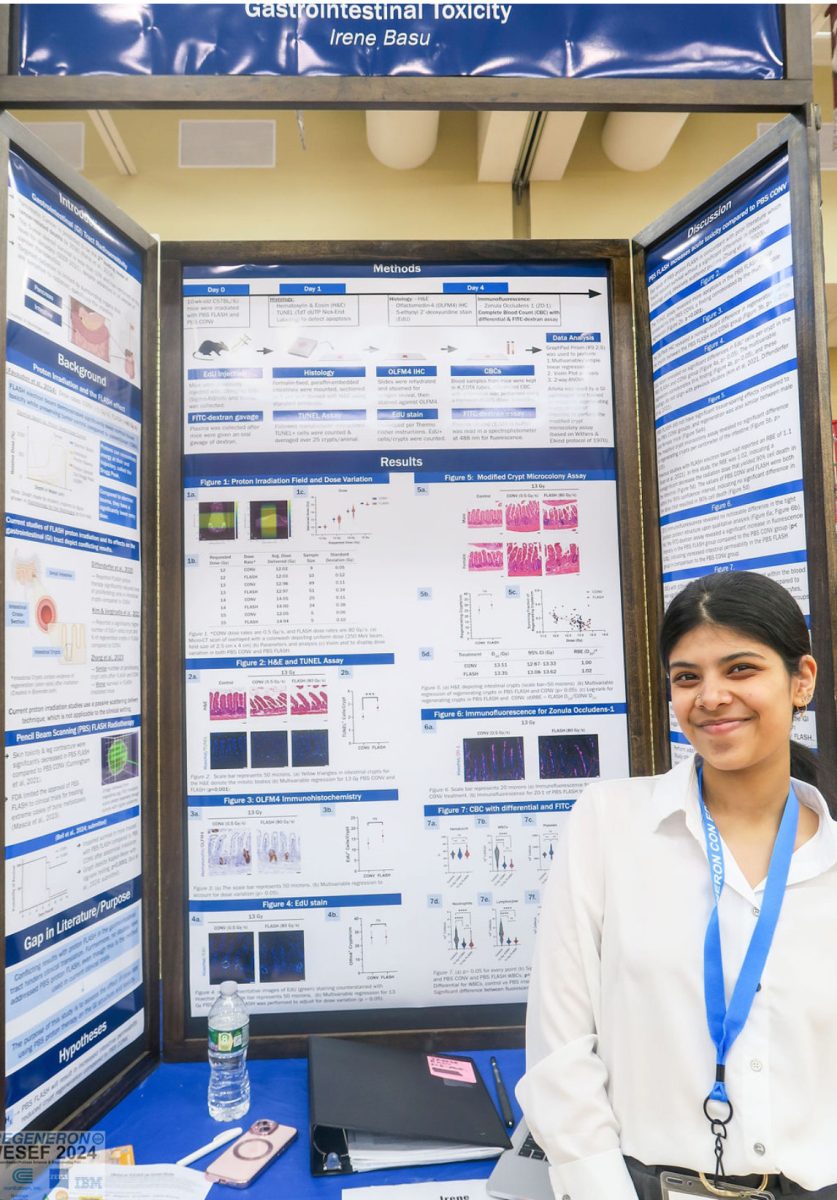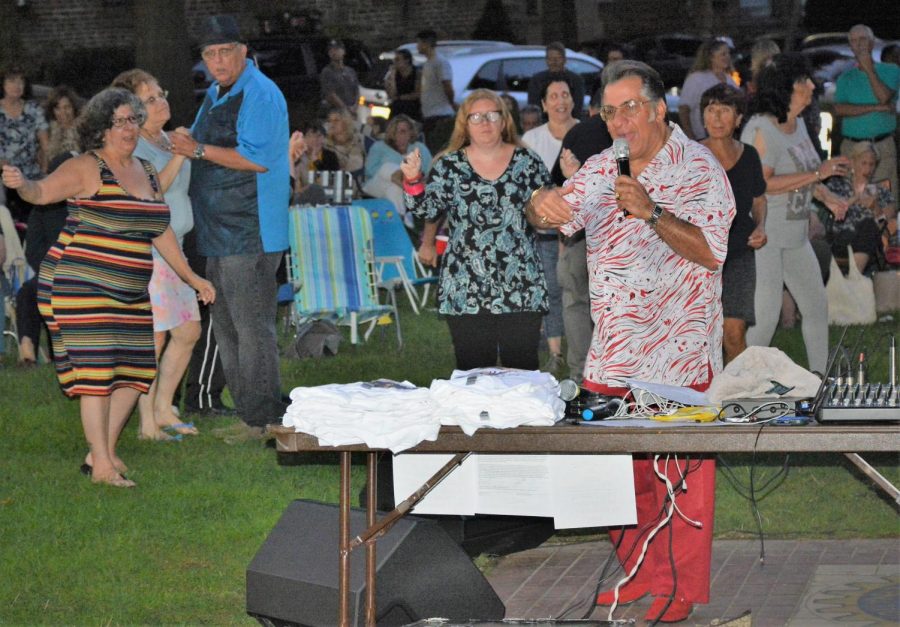Editor’s note: This press release was provided by the Pelham Union Free School District. The Pelham Examiner publishes press releases in the form received as a service to the community.
Pelham Memorial High School’s Science Research Program continued its incredible string of success at the 2024 Regeneron Westchester Science & Engineering Fair (WESEF) held in March. In total, Pelham students earned an incredible 38 awards with Sienna Giuseppi, Aadita Roy and Irene Basu each advancing to the prestigious International Science and Engineering Fair in Los Angeles in May!
“Year after year, WESEF Finalists compete and win against the best high school research students from all over the world,” said Science Research Director Steven Beltecas. “Congratulations to Sienna, Irene and Aadita and everyone who participated and helped make this event possible!”
WESEF encourages students to participate in hands-on science by providing a forum for showcasing the outstanding research of high school students in Westchester & Putnam counties of New York State and sponsoring the top students, 20 in total, from the fair to advance to ISEF.
The competition includes research projects from more than 700 students representing 40 schools in Westchester, Putnam & Sullivan counties. WESEF offers high school students from our region the opportunity to present their research to scientists, business leaders, and the general public.
Students prepare professional research posters detailing their projects which, in most cases, have involved complex research conducted under the guidance of a professional scientist in their field of interest.
Please see below for a full listing of awards won by PMHS students at WESEF as well as the project titles and is as follows:
American Psychological Association Award
Jamie Moskowitz, Behavioral and Social Sciences
NASA Earth System Science Award
Dennis Condon, Environmental Sciences
National Oceanic and Atmospheric Administration’s Taking the Pulse of the Planet Award
Gyan Schloyer , Environmental Sciences
BASF Expanding Knowledge in Science Award
Rediet Assefa, Environmental Sciences
Lauren Ulto, Environmental Sciences
Ingenuity in Math, Physics and Astronomy Award
Grace Kiamie, Physics and Astronomy
Momentive – Solutions for a Sustainable World Award
Judith Brandler, Biochemistry
Excellence in Computer Science and Mathematics Award
Henry Kagan, Mathematical Sciences
Visionary Engineering Award
Olivia Polsky, Environmental Sciences
Carl Zeiss Microscopy Award
Irene Basu, Medicine and Health Sciences
David M. Holmes WESEF Engineering Innovation Award
Sienna Giuseppi, Environmental Sciences
Honorable Mention Awards
Lucetta Dolan, Animal Sciences
Christopher Miklitsch, Animal Sciences
Emma Bier, Behavioral and Social Sciences
Jake Fellner, Medicine and Health Sciences
Joe Martucci, Medicine and Health Sciences
Alexandra Herzog, Neuroscience
4th Place Awards
Axel Robinson, Behavioral and Social Sciences
Megan McInerney, Behavioral and Social Sciences
Sabine Bushong, Behavioral and Social Sciences
Madelyn Turner, Environmental Sciences
Spencer Conrad, Environmental Sciences
Avery Goodman, Environmental Sciences
Justin Cohen, Medicine and Health Sciences
Genevieve Pereira, Physics and Astronomy
3rd Place Awards
Brewer Anderson, Behavioral and Social Sciences
Pierre Caillate, Environmental Sciences
Kira Findikyan, Medicine and Health Sciences
Shreyas Singh, Neuroscience
2nd Place Awards
Plum Durham, Behavioral and Social Sciences
Madeleine Pachella, Medicine and Health Sciences
Malachy Pearlman, Medicine and Health Sciences
1st Place Awards (ISEF Competitors)
Sienna Giuseppi, Environmental Sciences
“Harvesting Energy at Your Fingertips: Harnessing Mechanical Energy from Typing for Sustainable Power Generation”
Electricity production is one of the greatest contributors to CO₂ emissions. Laptops present themselves as one of the most widely used electronic devices in the world. Mechanical energy is constantly being dispersed onto the keys whenever in use. Piezoelectricity is the phenomenon in which electrical charge is accumulated in response to applied mechanical stress. Here, I explore the idea that piezoelectric material can be used to charge a device by harnessing the mechanical energy from each keystroke. While piezoelectric technology is widely recognized for its energy conversion capabilities, its application in small-scale energy harvesting, such as in computer keys, remains relatively unexplored. I addressed this over the course of three years, in a dual-phased study. Phase I explored the feasibility of this idea by inserting piezo discs beneath a laptop keyboard. Resultant voltages of 0.436V to 1.643V demonstrated the potential for energy generation during typing. During Phase II a prototype for a singular computer key specifically optimized for energy harvesting using piezoelectric materials was designed, constructed, and tested. While the structure of the key switch was redesigned to incorporate the piezoelectric plate, the key functioned identically to a typical key switch. Many iterations of the key were 3D printed and redesigned during the engineering process in order to maximize the pressure on the piezoelectric element while maintaining key function. The average force exerted on a computer key was determined. Average force during typing and the resultant voltage response of the device to that pressure underscores the feasibility of piezoelectric technology within a keyboard. The key was tested over a period of 10 seconds, yielding a peak of 0.403V per keystroke when subjected to the forces typically applied during typing; the mean value for typing force was determined to be 1.6N. The results were analyzed and compared to current research, providing evidence that this piezoelectric keyboard design can effectively generate electricity. This design offers a clean and more sustainable power source for laptops, thus contributing to reducing our carbon footprint and dependence on non-renewable energy sources through small-scale energy generation technology.
Aadita Roy, Medicine and Health Sciences
Pro-Inflammatory Macrophages Induce Pyroptotic Death of β-cells: Modeling Macrophage-Mediated Pancreatic Endocrine β-Cell Damage Using Human Pluripotent Stem Cell-Derived Vascularized Macrophage-Islet Organoids
Diabetes is one of the leading causes of death and disability worldwide. Loss of functional pancreatic β-cell mass is the key mechanism leading to type 1 diabetes (T1D) and type 2 diabetes (T2D). Islet macrophages have been shown to have important roles in pancreatic endocrine cells during development and homeostasis. Increasing evidence also supports the idea that these macrophages are involved in β-cell death, contributing to the physiopathology of T1D and T2D. However, the absence of an in vitro model that mirrors the cellular components of the human pancreas has made it difficult to dissect the key pathways involved in islet macrophage-mediated β-cell death. Organoids mirroring many human organs can now be generated from human pluripotent stem cells (hPSC) in vitro. In order to study the mechanisms by which pro-inflammatory macrophages induce β-cell death and the crosstalk involved between these cells, I constructed a novel human vascularized macrophage-islet organoid model derived from human hPSCs that consist of pancreatic endocrine cells, endothelial cells, and macrophages. To find potential mechanisms, I performed a comparative analysis of the organoids in the presence of unstimulated macrophages or pro-inflammatory macrophages. I found evidence of pro-inflammatory macrophage-induced pyroptotic death of β-cells, an inflammation-mediated form of programmed cell death. RNA seq analysis showed the specific upregulation of genes associated with pyroptosis, including included Gasdermin D (GSDMD), Caspase 1 (CASP1), Interleukin-18 (IL18), High mobility group box 1 (HMGB1), and N-terminal PYRIN-PAAD-DAPIN domain and a C-terminal caspase-recruitment domain (PYCARD). Together these data show that inflammatory macrophage-induced pyroptosis may lead to the loss of β-cell mass in diabetic pancreas. The hPSCs-derived vascularized macrophage-islet organoid I created provides a means for a more systematic understanding of immune cell-mediated damage of host β-cell in diabetes.
Irene Basu, Medicine and Health Sciences
Pencil Beam Scanning FLASH Radiotherapy Increases Acute Gastrointestinal Toxicity
Current radiotherapy treatment for abdominal and pelvic cancers typically results in some form of acute gastrointestinal (GI) toxicity in patients. X-ray irradiation to deep-seated abdominal tumors typically results in notable damage to normal tissue preceding it. Recent studies suggest that ultrahigh dose rate “FLASH” radiotherapy (~40 Gy/s) reduces normal tissue toxicity using electron beam and proton radiation. However, prior proton FLASH studies used clinically napplicable delivery methods. Hence, in this study, we utilized pencil beam scanning (PBS) FLASH proton irradiation, which has already been implemented in recent clinical trials, to investigate the effects on the GI tract. PBS FLASH and conventional (CONV) proton irradiation had been exposed to mouse intestinal tissue. Immunohistochemistry, immunofluorescence, complete blood counts (CBCs), crypt microcolony assays, and FITC-dextran assays were performed on isolated intestinal tissue samples. No significant differences were observed in the immunohistochemistry and immunofluorescence. CBCs revealed a significant decrease in circulating white blood cells between the control and irradiation groups (p<0.05). Furthermore, the FITC dextran assay revealed no significant difference in fluorescence intensity within the PBS proton irradiated group (p> 0.05). With this being the first study to investigate the effects of PBS FLASH irradiation on GI toxicity, it should be noted that PBS FLASH may result in increased acute GI toxicity in comparison to PBS CONV which does not depend on direct crypt cell killing.
- The Pelham Examiner reports on education from Kindergarten musicals to board of ed meetings. Give now to support the nonprofit community newspaper that covers Pelham schools.













